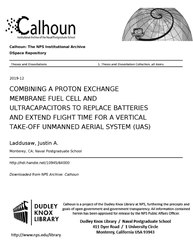File:COMBINING A PROTON EXCHANGE MEMBRANE FUEL CELL AND ULTRACAPACITORS TO REPLACE BATTERIES AND EXTEND FLIGHT TIME FOR A VERTICAL TAKE-OFF UNMANNED AERIAL SYSTEM (UAS) (IA combiningaproton1094564000).pdf

Original file (1,275 × 1,650 pixels, file size: 4.25 MB, MIME type: application/pdf, 86 pages)
Captions
Captions
Summary[edit]
| COMBINING A PROTON EXCHANGE MEMBRANE FUEL CELL AND ULTRACAPACITORS TO REPLACE BATTERIES AND EXTEND FLIGHT TIME FOR A VERTICAL TAKE-OFF UNMANNED AERIAL SYSTEM (UAS)
( |
||
|---|---|---|
| Author |
Laddusaw, Justin A. |
|
| Title |
COMBINING A PROTON EXCHANGE MEMBRANE FUEL CELL AND ULTRACAPACITORS TO REPLACE BATTERIES AND EXTEND FLIGHT TIME FOR A VERTICAL TAKE-OFF UNMANNED AERIAL SYSTEM (UAS) |
|
| Publisher |
Monterey, CA; Naval Postgraduate School |
|
| Description |
This research investigated the combination of a fuel cell and ultracapacitors to create a hybrid powertrain for a vertical take-off unmanned aerial system (UAS). This replaced the more common battery-only powertrain or the hybrid fuel cell-battery powertrain. A secondary power source, such as a battery or ultracapacitors, is required to assist a fuel cell with immediate load requests because a fuel cell was unable to supply instantaneous power. The fuel cell-ultracapacitor was tested using a power profile that was experimentally determined using a battery-powered vertical take-off UAS during take-off, hover, and landing. This tabletop experiment is meant to lead to a more refined solution that can be easily scaled to fit into a smaller future vertical take-off UAS. The fuel cell-ultracapacitor powertrain was able to meet the power requirements while also supplying power to the fuel cell itself, without an external power supply. Future work opportunities include scaling for implementation into a UAS platform and coding the power management software to optimally manage the proposed hybrid powertrain. Subjects: fuel cell; ultracapacitor; unmanned aerial system; hybrid powertrain |
|
| Language | English | |
| Publication date | December 2019 | |
| Current location |
IA Collections: navalpostgraduateschoollibrary; fedlink |
|
| Accession number |
combiningaproton1094564000 |
|
| Source | ||
| Permission (Reusing this file) |
This publication is a work of the U.S. Government as defined in Title 17, United States Code, Section 101. Copyright protection is not available for this work in the United States. | |
Licensing[edit]
| Public domainPublic domainfalsefalse |
This work is in the public domain in the United States because it is a work prepared by an officer or employee of the United States Government as part of that person’s official duties under the terms of Title 17, Chapter 1, Section 105 of the US Code.
Note: This only applies to original works of the Federal Government and not to the work of any individual U.S. state, territory, commonwealth, county, municipality, or any other subdivision. This template also does not apply to postage stamp designs published by the United States Postal Service since 1978. (See § 313.6(C)(1) of Compendium of U.S. Copyright Office Practices). It also does not apply to certain US coins; see The US Mint Terms of Use.
|
 | |
| This file has been identified as being free of known restrictions under copyright law, including all related and neighboring rights. | ||
https://creativecommons.org/publicdomain/mark/1.0/PDMCreative Commons Public Domain Mark 1.0falsefalse
File history
Click on a date/time to view the file as it appeared at that time.
| Date/Time | Thumbnail | Dimensions | User | Comment | |
|---|---|---|---|---|---|
| current | 03:26, 16 July 2020 |  | 1,275 × 1,650, 86 pages (4.25 MB) | Fæ (talk | contribs) | FEDLINK - United States Federal Collection combiningaproton1094564000 (User talk:Fæ/IA books#Fork8) (batch 1993-2020 #11686) |
You cannot overwrite this file.
File usage on Commons
The following page uses this file:
Metadata
This file contains additional information such as Exif metadata which may have been added by the digital camera, scanner, or software program used to create or digitize it. If the file has been modified from its original state, some details such as the timestamp may not fully reflect those of the original file. The timestamp is only as accurate as the clock in the camera, and it may be completely wrong.
| Short title | COMBINING A PROTON EXCHANGE MEMBRANE FUEL CELL AND ULTRACAPACITORS TO REPLACE BATTERIES AND EXTEND FLIGHT TIME FOR A VERTICAL TAKE-OFF UNMANNED AERIAL SYSTEM (UAS) |
|---|---|
| Image title | |
| Author | Laddusaw, Justin A. |
| Software used | Laddusaw, Justin A. |
| Conversion program | Adobe PDF Library 11.0 |
| Encrypted | no |
| Page size | 612 x 792 pts (letter) |
| Version of PDF format | 1.4 |

